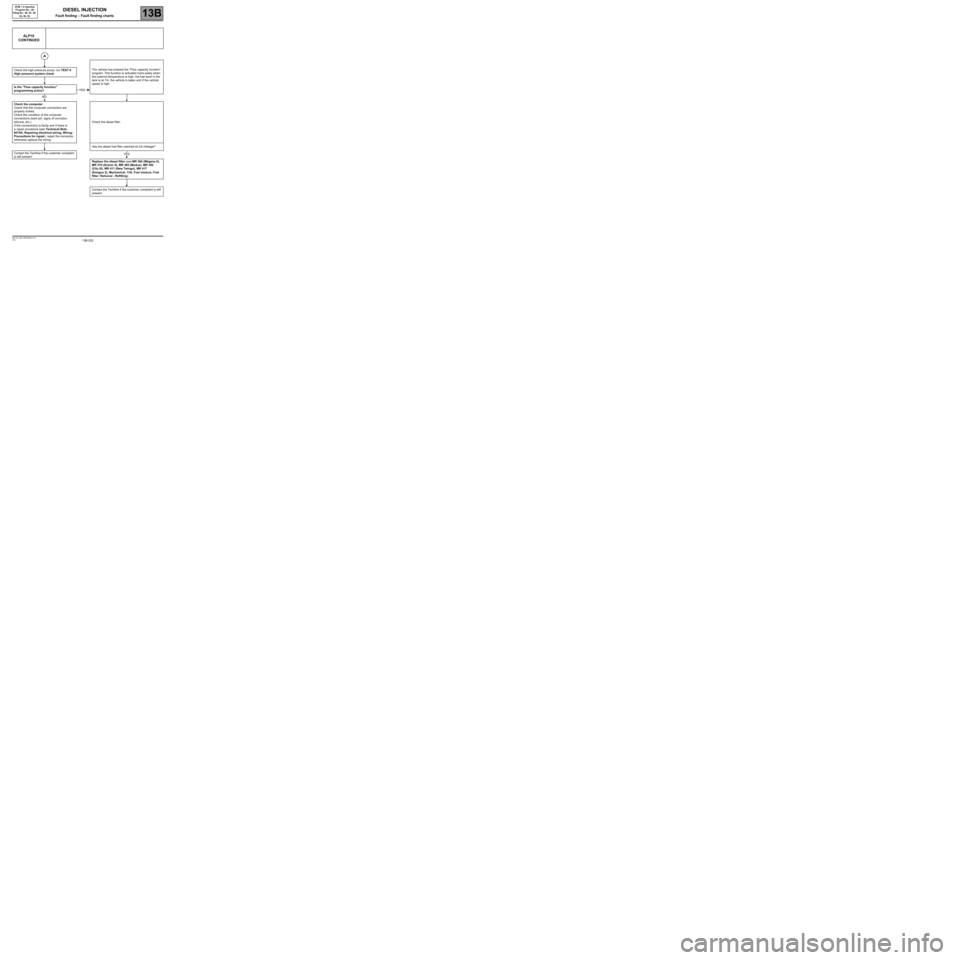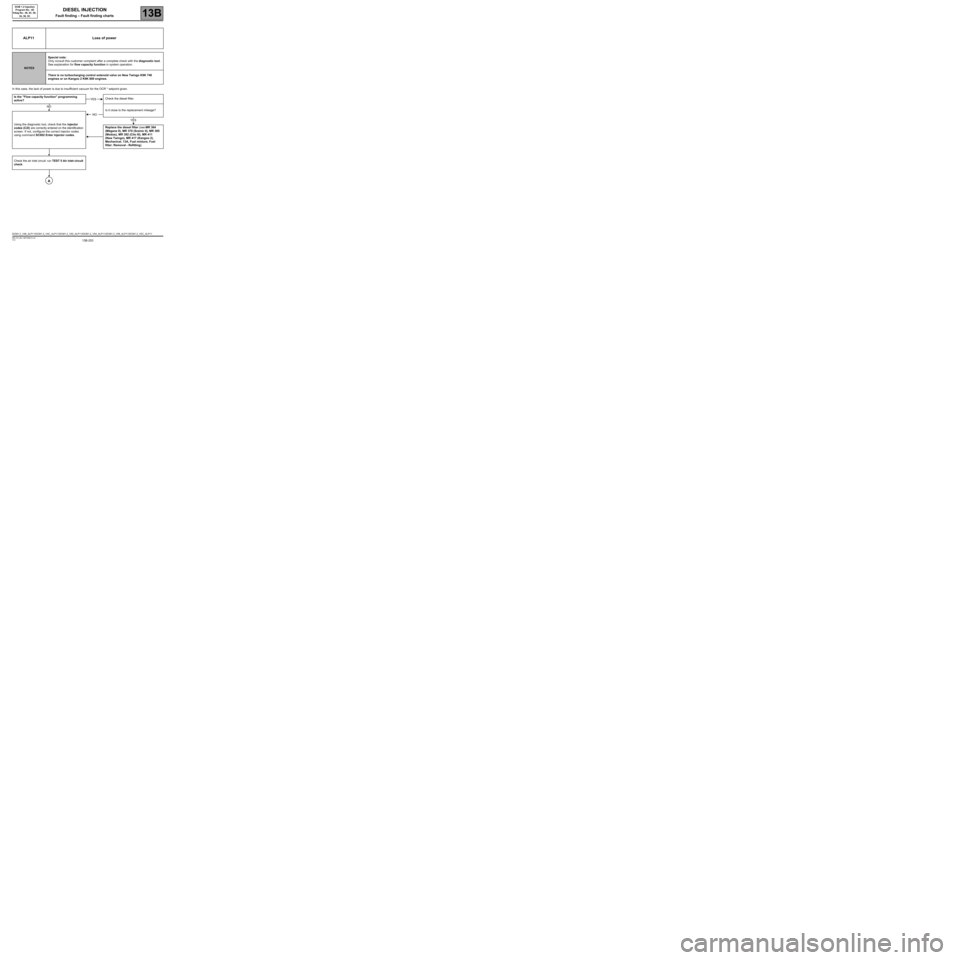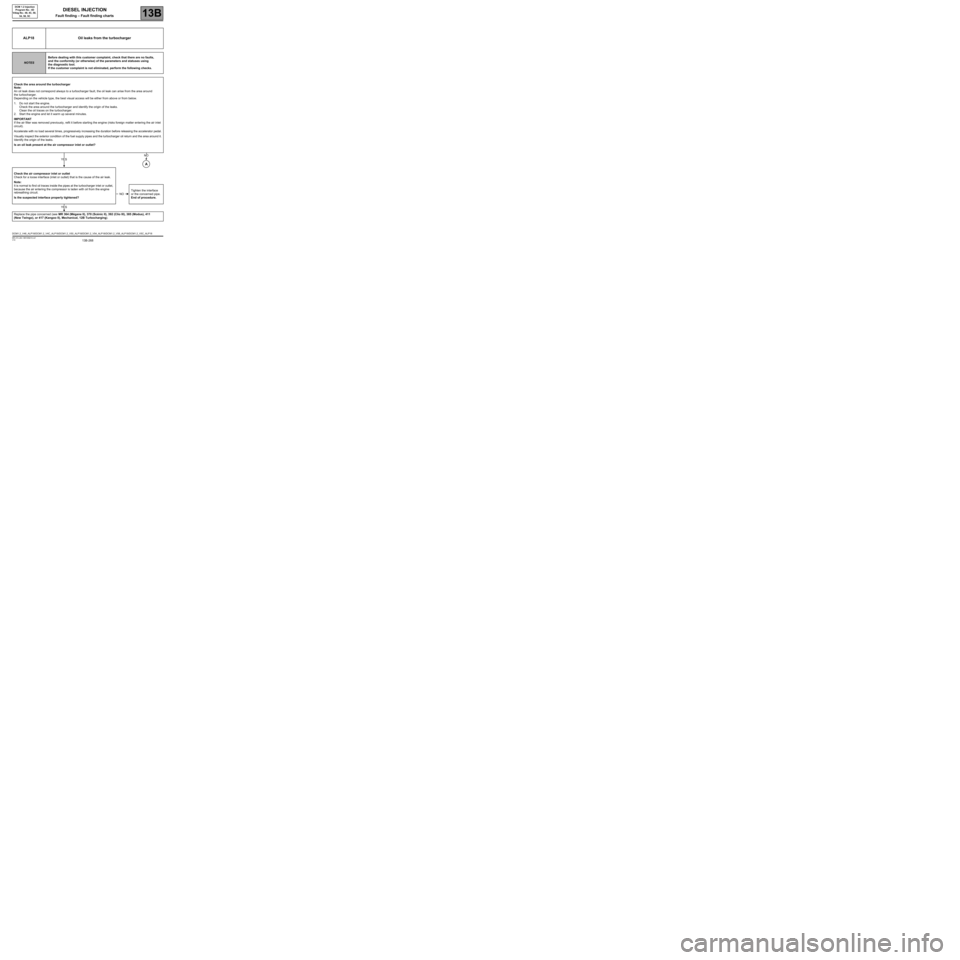air filter RENAULT SCENIC 2010 J95 / 3.G Engine And Pheripherals DCM 1.2 Injection Owner's Manual
[x] Cancel search | Manufacturer: RENAULT, Model Year: 2010, Model line: SCENIC, Model: RENAULT SCENIC 2010 J95 / 3.GPages: 269
Page 252 of 269

13B-252V10 MR-372-J84-13B100$210.mif
DIESEL INJECTION
Fault finding – Fault finding charts13B
DCM 1.2 Injection
Program No.: 4D
Vdiag No.: 48, 4C, 50,
54, 58, 5C
ALP10
CONTINUED
The vehicle has entered the "Flow capacity function"
program. This function is activated more easily when:
the external temperature is high, the fuel level in the
tank is at 1/4, the vehicle is laden and if the vehicle
speed is high. Check the high pressure pump: run TEST 6
High pressure system check.
Is the "Flow capacity function"
programming active?
Check the computer:
Check that the computer connectors are
properly locked.
Check the condition of the computer
connections (bent pin, signs of corrosion,
silicone, etc.).
If the connector(s) is faulty and if there is
a repair procedure (see Technical Note
6015A, Repairing electrical wiring, Wiring:
Precautions for repair), repair the connector,
otherwise replace the wiring.Check the diesel filter.
Has the diesel fuel filter reached its full mileage?
Contact the Techline if the customer complaint
is still present.
Replace the diesel filter (see MR 364 (Mégane II),
MR 370 (Scénic II), MR 385 (Modus), MR 392
(Clio III), MR 411 (New Twingo), MR 417
(Kangoo 2), Mechanical, 13A, Fuel mixture, Fuel
filter: Removal - Refitting).
Contact the Techline if the customer complaint is still
present.
A
YES
NO
YES
Page 253 of 269

13B-253V10 MR-372-J84-13B100$210.mif
DIESEL INJECTION
Fault finding – Fault finding charts13B
DCM 1.2 Injection
Program No.: 4D
Vdiag No.: 48, 4C, 50,
54, 58, 5C
In this case, the lack of power is due to insufficient vacuum for the OCR * setpoint given.
ALP11 Loss of power
NOTESSpecial note:
Only consult this customer complaint after a complete check with the diagnostic tool.
See explanation for flow capacity function in system operation.
There is no turbocharging control solenoid valve on New Twingo K9K 740
engines or on Kangoo 2 K9K 800 engines.
Is the "Flow capacity function" programming
active?Check the diesel filter.
Is it close to the replacement mileage?
Using the diagnostic tool, check that the injector
codes (C2I) are correctly entered on the identification
screen. If not, configure the correct injector codes
using command SC002 Enter injector codes.Replace the diesel filter (see MR 364
(Mégane II), MR 370 (Scénic II), MR 385
(Modus), MR 392 (Clio III), MR 411
(New Twingo), MR 417 (Kangoo 2),
Mechanical, 13A, Fuel mixture, Fuel
filter: Removal - Refitting).
Check the air inlet circuit: run TEST 5 Air inlet circuit
check.
YES
NO
NO
YES
A
DCM1.2_V48_ALP11/DCM1.2_V4C_ALP11/DCM1.2_V50_ALP11/DCM1.2_V54_ALP11/DCM1.2_V58_ALP11/DCM1.2_V5C_ALP11
Page 268 of 269

13B-268V10 MR-372-J84-13B100$210.mif
DIESEL INJECTION
Fault finding – Fault finding charts13B
DCM 1.2 Injection
Program No.: 4D
Vdiag No.: 48, 4C, 50,
54, 58, 5C
ALP18 Oil leaks from the turbocharger
NOTESBefore dealing with this customer complaint, check that there are no faults,
and the conformity (or otherwise) of the parameters and statuses using
the diagnostic tool.
If the customer complaint is not eliminated, perform the following checks.
Check the area around the turbocharger
Note:
An oil leak does not correspond always to a turbocharger fault, the oil leak can arise from the area around
the turbocharger.
Depending on the vehicle type, the best visual access will be either from above or from below.
1. Do not start the engine.
Check the area around the turbocharger and identify the origin of the leaks.
Clean the oil traces on the turbocharger.
2. Start the engine and let it warm up several minutes.
IMPORTANT
If the air filter was removed previously, refit it before starting the engine (risks foreign matter entering the air inlet
circuit).
Accelerate with no load several times, progressively increasing the duration before releasing the accelerator pedal.
Visually inspect the exterior condition of the fuel supply pipes and the turbocharger oil return and the area around it.
Identify the origin of the leaks.
Is an oil leak present at the air compressor inlet or outlet?
Check the air compressor inlet or outlet
Check for a loose interface (inlet or outlet) that is the cause of the air leak.
Note:
It is normal to find oil traces inside the pipes at the turbocharger inlet or outlet,
because the air entering the compressor is laden with oil from the engine
rebreathing circuit.
Is the suspected interface properly tightened?Tighten the interface
or the concerned pipe.
End of procedure.
Replace the pipe concerned (see MR 364 (Mégane II), 370 (Scénic II), 392 (Clio III), 385 (Modus), 411
(New Twingo), or 417 (Kangoo II), Mechanical, 12B Turbocharging).
YES
NO
A
NO
YES
DCM1.2_V48_ALP18/DCM1.2_V4C_ALP18/DCM1.2_V50_ALP18/DCM1.2_V54_ALP18/DCM1.2_V58_ALP18/DCM1.2_V5C_ALP18